Hitting a plane was not always associated with its complete destruction. History knows cases where a damaged machine landed safely. A lot of credit goes to the pilots.
It was supposed to be a flight like many:take off in the dark, reach the destination that was the city of Bremen that night, September 4, 1942. Then drop the bombs and return from the fiery hell towards the safe airport. In the Vickers Wellington bomber they took their places, 2nd Lt. Stanisław Machej, Capt. obs. Bolesław Biliński, 2nd Lt. Zbigniew Brzeziński, Sergeant Klemens Muszyński and Senior Sgt. Józef Tomiec. Their plane, belonging to the 300 Bomber Squadron, bearing code letters BH Z and proper name "Zośka", was considered a happy machine . So the airmen believed that nothing bad would happen to them.
At that time, 251, mostly four-engine machines, were flying over Bremen. There were fewer Wellingtons - 98 aircraft. In fact, happiness, which Aleksander Chełstowski, navigator and bombardier of the 300 Squadron, wrote about in his "A handful of memories from the life of a vagabond soldier", accompanied them on their way to their destination, but then turned away for a moment. The pilot took the return course given by the navigator and noticed the silhouette of another twin-engine plane flying nearby with the position lights on. The Polish crew did not have much time to wonder who could accompany them, because the plane they saw headed towards "Zośka" and opened fire. It was a German Messerschmitt 110 night fighter version.
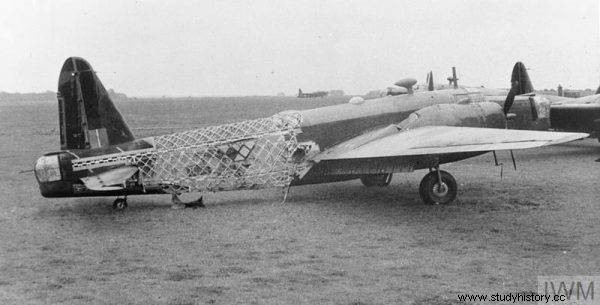
"Zośka" bomber after a successful landing at the base
Already the first series injured the rear gunner, the next ones torn the fuselage, smashing the radio station, the lifeboat, and worse - igniting the canvas of the rear part of the plane. A fire broke out and from that moment the bomber became visible to other crews and to the casts of the German anti-aircraft artillery . At the same time, Stanisław Machej, a graduate of the would-be 14th promotion of the Air Force Officer Cadet School in 1939, fought for the lives of the crew, dodging attacks by a German fighter. Eventually it flew into the clouds and the Messerschmitt flew away.
And then again "Zośka" smiled with happiness, as if it wanted to make up for its absence over Bremen:although the fire consumed the canvas covering the rear part of the fuselage and revealed the characteristic, geodetic skeleton of the plane, Wellington was still under the pilot's control. With damaged rudders, a leaky fuel tank, with a silent radio, a burning and interrupting engine - but it flew ! Although slower and lower…
The crew prepared for a parachute jump, but eventually the plane crossed the English shoreline and reached Ingham Airport. There, overcoming problems with the landing gear extension, he landed safely. A wounded rear gunner was dragged from the cabin. It turned out that everyone aboard the bomber, decorated from the inside with a doll in Krakow clothes, survived. Apart from the shooter, the radio operator was also injured. It was undeniable that the skill of the pilot and the characteristic geodesic truss of the aircraft structure, which saved the lives of many a crew - passed the test. "Zośka" proved that she was in fact a happy plane.
He didn't want to land sooner
Another case is described by Adam Zamoyski in the pages of "Eagles over Europe":
"Sergeant Major Pietrach, Wellington B's Commander, like Baby of Squadron 301, was an experienced pilot and had a good crew. One night over St. The Nazaire withstood the blows of thirty shrapnel shards, then managed to shoot down the night fighter that got in their way. "
In subsequent flights, the pilot did not want to risk a flight to his home base when the plane hit the target and tried to land at the nearest English airport, right after crossing the shoreline. The crew was not thrilled:they returned to their own people with a long delay, and the mechanics were suspected that they had not prepared the plane very well. The pilot was also joked . It was similar when all the bombers returned from one of the raids, except for one - "B". It was suspected that the pilot had traditionally landed elsewhere as the sergeant major reported via radio:
"It is flying on one engine, its wing tip has been torn off, the fuel tanks are leaking and there is a fire in the observer's cabin."
In this situation, he was ordered to land at the nearest airport, but after a few minutes the base announced that Wellington flew over the airport with only one efficient engine, with a hanging wing tip, a jagged fuselage, with an open and swaying bomb bay door and ... flew on. After a few minutes, officers from the next base on the bomber's route called with a similar report. Finally, the heavily damaged machine was pulled to the home airfield and landed firmly on its stomach.
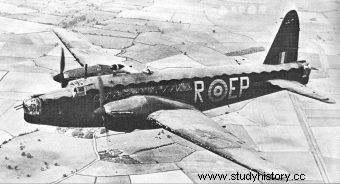
Vickers Wellington Mk.II of 104 Squadron RAF, 1941/42
In both cases, the crews benefited from the aforementioned strong Wellington structure, based on a truss made of light, bent pipes forming the fuselage shell, or the wing skeleton. Thanks to it, many Wellington returned to base with damage that at first glance should have caused the plane to crash in flight.
Fortress with a beak torn off
Few planes survived with such severe injuries. Some of them were hit hard and, although they had no chance of a safe landing, they gave their crew a moment to evacuate. The Americans have their "Zośka" in the form of a four-engine Boeing B17 bomber with its own name "Mizpah", which in Hebrew means "watchtower". This bomber - version G, numbered 42-32109 - flew in combat from January 1944, as part of 840 bomber squadron, 483 Bomb Group. On July 14, 1944, he flew over Hungary to bomb a refinery in the Budapest area, with the crew:Lieutenant Ewald A Swanson, Sec. Paul Berndt, Gramenzi, Simonelli, Hishem, Bell, Kelley, Tucker, as well as two - Bombardier Kenneth W. Dudley and navigator Joseph H. Henderson.
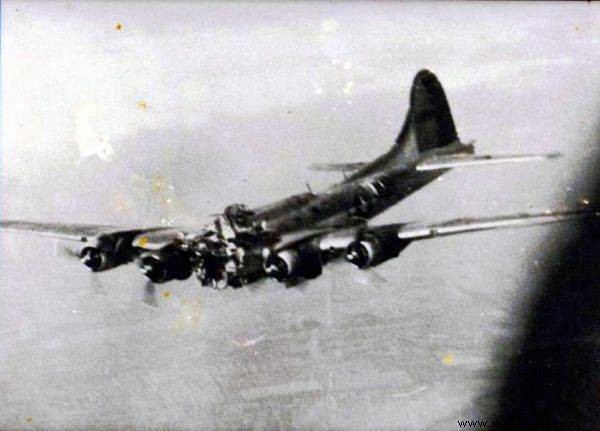
One of its shells hit the Mizpah directly, completely detaching the forward fuselage into the cockpit.
Seeing the approaching machine, the German crew of 88mm anti-aircraft guns took a good aim and one of its shells hit the Mizpah directly, completely detaching the front part of the fuselage as far as the cockpit. The bombardier and navigator died as a result of the hit, and the plane was badly damaged (the pilots had a demolished cockpit, among others), but Boeing, with a big hole, was still holding on to the air . However, the crew knew that it was falling, speed and altitude were decreasing, so they would not return to their home airport.
As it turned out, the pilots held the crippled bomber for about ten minutes. That's enough time to evacuate the parachuted crew. Apart from the two officers mentioned, no one else was killed, although for the rest of the flight, the war was over:eight were caught and sent to a POW camp.
It was possible to walk through the hole
The history of badly damaged planes returning to the bases is supplemented by the story of Edward Jaworski, the pilot of the 315 Squadron, who on October 21, 1941, after fighting the Messerschmitts over Lille, managed to return to the base with a sieve-filled Spitfire fighter. At that time, Polish and British newspapers published photos of the pilot, who was standing under the wing, his head and shoulders sticking out of a large hole torn out by shells from German aircraft cannons.
Stanisław Czarnecki, the pilot of the 308 Squadron, who was flying the Spitfire Mk IX, ML116, on May 21, 1944, was hit by an anti-aircraft artillery shell on May 21, 1944. The explosion almost tore the fighter's fuselage behind the cabin:it torn holes right through, one of which surely exceeded half the height of the fuselage! The plane, however, allowed to lead to the base, the pilot landed successfully, and the Spitfire ... was renovated and returned to action .
The story of the American Second Lt. Alton Frazer, illustrated with a photo of his Corsair fighter - difficult to fly, but liked by pilots for its strong construction. Well, Frazer took part in a fighter sweep over Okinawa on June 22, 1945, flying in a group of about 20 Corsair led by Major Orvin H. Ramlo, when he encountered about 30 excellent N1K2-J Shiden-Kai fighters, which in terms of performance gave themselves advice with American Hellcats, Corsair and even the latest versions of excellent Mustangs.
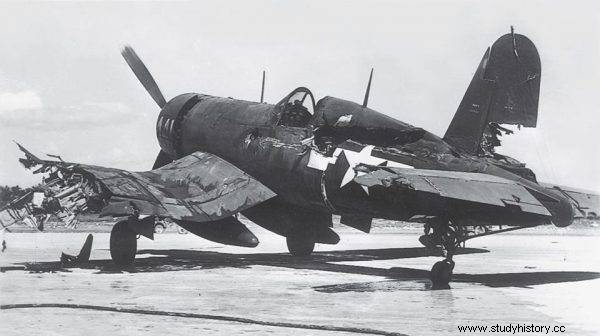
Frazer's plane became the star of press photos - looking at his photos, it's hard to believe that he managed to fly to the airport and land!
The planes that intercepted the American fighters were flown by veterans under the command of Lieutenant Oshibuchi. During the fight, Frazer hit the plane of Lieutenant Keiijro Hayashi, who was just flying in front of the Corsair, in a short series. He did not have time to enjoy his success, because a series of cannon shells from another Japanese fighter chopped off a large chunk of his wing, vertical stabilizer and the fuselage behind the cabin . The crippled Corsair broke free from the fight and managed to land happily. The Americans were very lucky then, paying with two planes for the loss of four Japanese. And Frazer's plane became the star of press photos - looking at his photos, it's hard to believe that he managed to fly to the airport and land!
Flight without a wing
The latest history of aviation is also full of similar and unbelievable events. On October 20, 2014, three Kansas National Guard F-16C fighters practiced aerial combat. At one point, the two pilots made turns without observing each other and just collided. One of the 16's fell and crashed (the pilot managed to catapult), while the other, with the wing more or less torn off, flew about 150 km more and landed at base.
In another story, the Israeli F-15 lost its wing in a similar way. On May 1, 1983, two F-15 fighters simulated a fight with four A-4N Skyhawk attackers. One of the "fifteen" was a new, only three-year-old plane, but already meritorious:on the side it had the markings of two downed MiG-21s and two MiG-23s. It was called "Markia Shchakim" and was crewed by pilot Zivi Nedivi and navigator Yehoar Gal.
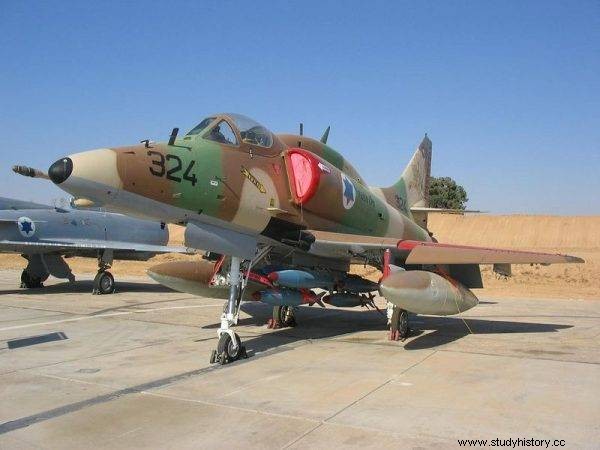
On May 1, 1983, two F-15 fighters simulated a fight with four A-4N Skyhawk attackers.
During this training fight over the Negev desert, the said fighter collided with one of the passing Skyhawks. The stormtrooper exploded, but his pilot catapulted. The F-15, on the other hand, lost almost its entire wing and a large supply of fuel, but the driver managed to, turning on afterburners and using electronic control systems, to take a course on its own Ramon base . Landing was risky because when the pilot slowed down, the plane immediately lost control.
On the other hand, the crew, intending to save the plane, did not want to eject. There was therefore no other option but to approach the landing at very high speed, twice the speed of the regulation. With a speedometer of 480 km / h, the plane hit the runway with its wheels. At this point, the hook, whose task was to hook the rope on the belt and brake, fell off. Eventually the machine stopped by itself, just in front of the net stretched at the end of the runway.
It was only when the crew emerged from the mutilated "fifteen" that they realized that the plane had lost its wing . Earlier, the aviators, busy fighting for survival, did not even notice it. Nobody gave them the news over the radio either! The pilot admitted that it was a good thing, because if he knew he was flying without a wing, he wouldn't have risked landing and he and the other crew member would simply eject.
